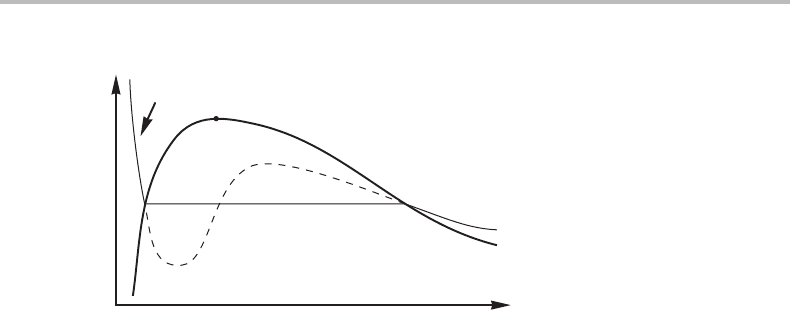Hillert M. Phase Equilibria, Phase Diagrams and Phase Transformations: Their Thermodynamic Basis
Подождите немного. Документ загружается.


17.6 Mechanisms of interface migration 395
A
B
f
A
D
A
f
A
D
A
f
B
D
B
f
B
D
B
D
B
D
co
f
co
D
co
f
co
D
co
β
α
D
G
m
D
A
x
B
α/β
x
B
β/α
x
B
tr
x
B
co
Figure 17.3 Precipitation of β from α by three processes, individual diffusion of A and B and a
cooperative mechanism. The dissipations per mole of transferred atoms are obtained from each
driving force multiplied by the fraction of its flux, f
j
= J
j
/(J
co
+ J
i
).
An alternative way of reducing the net effect of the three processes to an effect of
two may be preferable. One would then divide the cooperative flux on the individual
components obtaining J
co
j
= x
co
j
J
j
.For the total flux of component j one would then
obtain
J
total
j
= J
j
+ x
co
j
J
co
=
"
x
α/β
j
x
β/α
j
M
j
(−µ
j
) + x
co
j
(M
α:β
/V
m
)
x
co
i
(−µ
i
)
(17.68)
Then one could determine the composition of the cooperative mechanism by inserting
Eq. (17.68) into Eq. (17.56), whose right-hand side is given by the fluxes inside the α
and β phases.
We can now see from Eq. (17.68) that by adding the cooperative mechanism to the
individual diffusion of the components we have actually entered cross terms into the
individual phenomenological equations. It may thus seem that one could have obtained
the same effect by taking cross terms into account directly without modelling any mech-
anism. However, there is a major difference. Through the presence of x
co
j
and x
co
i
Eq. (17.68), which are related to the fluxes inside the phases through Eq. (17.56), it
is possible to make the cross coefficients change automatically as the growth conditions
vary during a process. Furthermore, through Eq. (17.68) the cross coefficients of various
components are related and the summation in Eq. (17.68) also contains a term for the
component under consideration, i.e. for i = j,and it will also change with the growth con-
ditions. Finally, it will also be easy to introduce a non-linear kinetic law for the cooperative
part of the phase transformation by making the mobility M
α:β
depend on the velocity.
Exercise 17.8
Prove that the introduction of the processes defined by Eqs (17.60) to (17.63) actually
kept the rate of entropy production invariant.

396 Kinetics of transport processes
Hint
One can add
J
n
− x
n
n
k
J
k
(
D
n
− D
n
)
which is equal to zero.
Solution
n
i=1
J
∗
i
D
∗
i
=
n−1
i=1
J
i
− x
i
n
k
J
k
(
D
i
− D
n
)
+
n
i=1
J
i
n
k
x
k
D
k
=
n
i=1
J
i
D
i
− J
i
D
n
− x
i
D
i
n
k=1
J
k
+ x
i
D
n
n
k=1
J
k
+
n
k=1
J
k
n
i=1
x
i
D
i
=
n
i=1
J
i
D
i
− D
n
n
i=1
J
i
−
n
k=1
J
k
n
i=1
x
i
D
i
+ D
n
n
k=1
J
k
n
i=1
x
i
+
n
k=1
J
k
n
i=1
x
i
D
i
=
n
i=1
J
i
D
i
.
17.7 Balance of forces and dissipation
We shall now examine how the driving forces and dissipations of Gibbs energy are
balanced in a simple case of diffusional phase transformation. The equation for diffusion
by the vacancy mechanism will be applied. A limited mobility of the interfaces will also
be considered. Svoboda et al.[36] has emphasized that this is a case where it may be an
advantage to apply Onsager’s extremum principle from Section 5.9 because one cannot
make any a priori assumption about the conditions at the migrating interfaces if there
is friction in them and those conditions are usually required as boundary conditions for
solving the diffusion equations inside the phases. We shall follow that procedure.
We shall consider a binary case where all phases have almost constant compositions
and a β phase is being formed from an initial interface between an A-rich α phase and
a B-rich γ phase. In α and γ there will be no diffusion. The system is shaped as a rod
with a constant cross-section of a and with the α:γ interface perpendicular to the length
coordinate. Because the β phase has an almost constant composition, the fluxes of A or
B can at each moment be approximated as constant through the whole length of β.
First we must find the rate of change of Gibbs energy of the whole system. Gibbs
energy per area a of the rod is
G/a = l
ϕ
G
ϕ
m
V
ϕ
m
, (17.69)
wherel
ϕ
is the length of the respective phase. The velocities of the interfaces are obtained
from the time derivatives of l
ϕ
and the rate of change of Gibbs energy will be
˙
G
a
=
G
ϕ
m
υ
ϕ
V
ϕ
m
= G
α
m
υ
α/β
V
α
m
− G
β
m
υ
β/α
V
β
m
+ G
β
m
υ
β/γ
V
β
m
− G
γ
m
υ
γ/β
V
γ
m
. (17.70)

17.7 Balance of forces and dissipation 397
A
B
α
β
γ
∆µ
A
µ
A
α/β
µ
A
β/γ
µ
B
β/γ
µ
B
α/β
G
m
x
α
x
β
x
γ
Figure 17.4 Molar Gibbs energy diagram for a system with three phases. A will diffuse from the
α/β interface to the β/γ interface and B in the other direction. β will grow into both α and γ.
By inserting the velocities from Eqs (17.49) and (17.50)wecan evaluate two driving
forces for diffusion through the β phase, ∂
˙
G/∂ J
β
A
and ∂
˙
G/∂ J
β
B
.
1
a
∂
˙
G
∂ J
β
A
=
−G
α
m
x
β
B
+ G
β
m
x
α
B
x
α
A
− x
β
A
+
G
β
m
x
γ
B
− G
γ
m
x
β
B
x
β
A
− x
γ
A
. (17.71)
Figure 17.4 illustrates that this result can be expressed as µ
A
= µ
β/γ
A
− µ
α/β
A
,where
the chemical potentials are evaluated for full equilibrium between the phases across the
interface, as if there were no losses in the interface. The diagram shows that µ
A
is
negative and we have thus a positive driving force for diffusion of A in the direction
from α to γ.Onthe other hand, µ
B
will be positive and the driving force for B would
thus drive B in the opposite direction.
The rate of dissipation of Gibbs energy for a process is given by Eq. (5.133)ifthe
cross coefficients can be neglected,
φ
i
= X
i
J
i
= (1/L
ii
)J
2
i
. (17.72)
We shall first apply this to the two individual diffusion processes. As explained below
Eq. (17.6), for diffusion this is the dissipation per volume of the phase. We can easily
integrate over the whole length of the β phase because the fluxes can be treated as
constant, as already explained. The volume of the β phase is a · l
β
and the diffusion
equation, Eq. (17.10), yields for diffusion of A,
φ
A
= al
β
J
2
A
L
AA
= al
β
J
2
A
M
β
A
x
β
A
. (17.73)
We shall soon need the derivative with respect to the diffusion fluxes, e.g.,
1
a
∂φ
A
∂ J
β
A
=
2l
β
J
A
M
β
A
x
β
A
. (17.74)
The present problem would have been trivial if the two diffusion processes were the
only ones to consider. However, we shall also consider friction of the migrating interface
caused by a cooperative mechanism. For that process one would perhaps like to apply
Eq. (17.4)but there is a problem because, according to Section 17.5, there are two

398 Kinetics of transport processes
different velocities depending on what lattice is used as reference. The difference is
caused by the two elements having different diffusivities in the β phase. The velocity
relative to the lattice of the β phase is affected by the difference resulting in a net
transportation of vacancies to or from the interface. However, there is no diffusion in
the α phase and the velocity relative to that lattice is caused only by the atoms crossing
the interface. We shall thus use υ
α/β
from Eq. (17.49). Furthermore, there is a factor
V
m
on the right-hand side of Eq. (17.4)which may also be different for the two phases.
However, it was eliminated in Eq. (17.5) although the choice of V
m
in Eq. (17.4) has
affected the value of the mobility M. The rate of dissipation of Gibbs energy due to the
friction in the interface is thus obtained as
T σ
α/β
= φ
α/β
= aυ
α/β
−G
m
V
α
m
= a
1
M
α/β
(υ
α/β
)
2
= a
V
α
m
2
M
α/β
υ
α/β
V
α
m
2
.
(17.75)
Comparison with Eq. (17.73) shows that the thickness of the interface has been included
in the mobility. Using Eq. (17.49)wecan evaluate the derivatives with respect to the
fluxes,
1
a
∂φ
α/β
∂ J
β
A
=
2
V
α
m
2
M
α/β
υ
α/β
V
α
m
−x
β
B
x
α
A
− x
β
A
. (17.76)
We get similar equations for the β/γ interface. The complete dissipation function will
be
= φ
A
+ φ
B
+ φ
α/β
+ φ
β/γ
. (17.77)
We can evaluate ∂/∂J
β
A
and ∂/∂J
β
B
and Onsager’s extremum principle, Eq. (5.141),
yields two kinetic equations,
−
∂
˙
G
∂ J
β
i
=
1
2
∂
∂ J
β
i
, (17.78)
where i is either A or B. In principle we can thus solve for J
β
A
and J
β
B
.Wecan insert
the right-hand side of Eq. (17.71), which is equal to µ
A
according to Fig. 17.4, and of
Eq. (17.74). By first omitting the effects of the friction in the interfaces we find
− µ
A
=
l
β
J
A
M
β
A
x
β
A
; − µ
B
=
l
β
J
B
M
β
B
x
β
B
(17.79)
J
A
=
M
β
A
x
β
A
l
β
(−µ
A
); J
B
=−
M
β
B
x
β
B
l
β
µ
B
. (17.80)
These are well-known equations obtainable by classical methods. However, the result
will be more complicated byincluding the effectsfrom the interfaces givenbyEq. (17.76).
− µ
A
=
l
β
J
β
A
M
β
A
x
β
A
+
V
α
m
2
M
α/β
υ
α/β
V
α
m
−x
β
B
x
α
A
− x
β
A
+
V
γ
m
2
M
β/γ
υ
γ/β
V
γ
m
x
β
B
x
β
A
− x
γ
A
. (17.81)
J
A
=
M
β
A
x
β
A
l
β
−µ
A
+
V
α
m
2
M
α/β
υ
α/β
V
α
m
x
β
B
x
α
A
− x
β
A
−
V
γ
m
2
M
β/γ
υ
γ/β
V
γ
m
x
β
B
x
β
A
− x
γ
A
. (17.82)

17.7 Balance of forces and dissipation 399
In the present case where β grows into both α and γ, υ
α/β
is negative and υ
γ/β
is
positive. Equation (17.82) demonstrates that for weak effects of friction they may both
be regarded as negative corrections to the driving force, −µ
A
, caused by deviations
from local equilibrium at the interfaces. For stronger effects it may be more natural to
regard them as dissipations of Gibbs energy as in Eq. (17.81). There may be a numerical
problem because the contributions from the interfaces contain the velocities and they are
functions of the fluxes. However, with computerized methods there should be no great
problem.
With this example we have demonstrated that even in a case with several processes
that dissipate Gibbs energy it may be possible to formulate the kinetic equations directly.

18
Methods of modelling
18.1 General principles
By ‘modelling’ we shall understand the selection of some assumptions from which it is
possible to calculate the properties of a system. Sometimes it is possible to obtain a close
mathematical expression giving a property as a function of interesting variables. In this
chapter and the following ones we shall mainly concern ourselves with such models.
However, in many cases the model cannot be expressed in a closed mathematical form
but results can also be obtained by numerical calculations using some iterative method.
When the iteration in some way resembles the behaviour of a real physical system one
talks about ‘simulation’. Such methods are becoming increasingly more powerful thanks
to access to more and more powerful computers.
The purpose of modelling is two-fold. From a scientific point of view one likes to
learn how nature functions. One way of gaining knowledge is to define some hypothesis
resulting in a model and test it by comparing the predictions from the model with
experimental information. Then, it does not matter much if the predictions are made
by an analytical calculation or by some numerical method. From a more technological
point of view one likes to predict the properties of a particular system in order to put it to
efficient use in some practical construction or operation. Then it is often most convenient
to have a model which yields an analytical expression.
In the simplest case, modelling is just the selection of a mathematical form which has
proved useful, whether it is based on some physical model or not. However, experience
shows that a model is usually more powerful if it is based upon physically sound princi-
ples. With such a model one can hope to make predictions outside the tested range with
some confidence.
The first question to discuss is what thermodynamic function to model. That question
will be addressed in the next section.
Exercise 18.1
Figure 18.1 shows a P, V diagram for a pure substance at a high temperature where only
gas and liquid exist. Above the critical point c there is no sharp difference between the
two phases. It is thus tempting to try to apply a single mathematical model for both phases
but it would then give values also for one-phase states inside the two-phase field, i.e.,
below the thick line. Such states would be metastable or unstable. The thermodynamic

18.2 Choice of characteristic state function 401
L
gas
1
1
P
V
isotherm
c
A
1
A
2
Figure 18.1 See Exercise 18.1.
properties of unstable states may be questioned but it seems reasonable at least to obey
basic thermodynamic principles when constructing the model.
The thin line represents an isotherm. Show that the model must be constructed in such
away that the two areas A
1
and A
2
are equal. Actually, this is a way of identifying the
equilibrium points, L
1
and gas
1
,onthe curve from a model that extends over the whole
range (sometimes called Maxwell’s construction).
Hint
Evaluate the change in Gibbs energy along the dashed line. It is an isothermal change and
thus dG = V dP − SdT = V dP. Then remember that the Gibbs energy of L
1
and gas
1
must be equal because they represent two states of the same substance in equilibrium
with each other at given values of P and T.
Solution
G(gas
1
) − G(L
1
) =
V dP = A
1
− A
2
. But G(gas
1
) = G(L
1
). Thus, A
1
= A
2
. This
result demonstrates that satisfactory modelling is more than just choosing a mathematical
expression.
18.2 Choice of characteristic state function
From a practical point of view we are most interested in models giving the Gibbs energy
which has temperature and pressure as its natural variables. They are usually the most
convenient experimental variables. On the other hand, the physical model itself may
make a different choice more natural. An example is the effect of thermal vibrations of
the atoms. The frequencies depend upon the forces between atoms which in turn, depend
upon the atomic distances. In that case it is most straightforward to consider the effect
under a constant volume in spite of the fact that the vibrations themselves tend to expand
the system. It is thus natural to consider the Helmholtz energy. The formation of thermal
vacancies is a very different case. There the physical picture is that an atom is removed

402 Methods of modelling
from the interior of a crystal and placed on the surface. The volume is thus increased by
one lattice site. If the atomic distances are to be kept constant, it is now necessary to let
the volume increase. It will thus be more straightforward to consider this process under
a constant pressure and to work with the Gibbs energy. It may be emphasized that one
should choose to model the internal energy only for a case where it is natural to consider
entropy and volume as constant and that may be very rare. On the other hand, there may
be cases where the internal energy and the volume are kept constant and one could then
model the entropy.
A different question is how to model the simultaneous effects of two different phe-
nomena. It is true that the law of additivity applies to all the extensive state functions as
farascontributions from different parts of the system are concerned. However, it must be
remembered that the internal energy, volume or entropy of the whole system is then the
sum of the values for the parts, whereas the variables T and P are often the same in all the
parts and in the whole system. If there are curved interfaces between different parts then
the parts may be under different pressures and it must be remembered that the variable
P in the Gibbs energy for the whole system refers to the externally applied pressure. It
may then be more straightforward to consider the Helmholtz energy but, even so, one
must take into account the effect of the actual pressure inside each part because it affects
the molar volume.
The situation is quite different if each one of two phenomena applies to the whole
system. Each phenomenon may contribute to the total pressure which may be regarded
as the sum of two partial pressures but only if the two phenomena do not interact with
each other. On the other hand, the two phenomena in this case refer to the same volume.
In the present chapter the discussion of modelling will simply be limited to the use of
Gibbs energy.
Exercise 18.2
What would be the most natural quantity to use in a model of evaporation of a solid?
Hint
Consider which state variables should be kept constant in order to leave the bulk of the
solid unaffected by the process of evaporation.
Solution
It is not convenient to require that the volume should stay constant because then one
must compress the solid to make room for the vapour. The bulk will be unaffected if the
pressure is kept constant. One should thus model the Gibbs energy.
18.3 Reference states
As an introduction to our discussion of the modelling of the Gibbs energy it is instructive
to examine some real cases. The Gibbs energy is always given relative to some reference.

18.3 Reference states 403
o
G
m
bcc
–
o
G
m
fcc
o
G
m
hcp
–
o
G
m
fcc
o
G
m
liq
–
o
G
m
fcc
10
−10
0 2000
T (K)
G
m
(kJmol)
Figure 18.2 The Gibbs energy of various forms of iron, given relative to the fcc form at the same
temperature and a pressure of 1 bar.
As an example, if one inquires about the Gibbs energy for the various forms of pure solid
iron one may find information on all the other forms relative to the fcc form. Figure 18.2
shows how these Gibbs energy differences vary with temperature at 1 bar. It is a striking
feature that such curves are often rather straight but in some regions the curvature is
strong.
Since the negative slope of these curves is identical to the entropy difference between
the two phases, we may conclude that the entropy difference is often rather constant.
In regions of strong curvature there is a strong variation of the entropy difference and
this should in turn be due to some special physical effect. The strong curvature in
o
G
bcc
Fe
−
o
G
fcc
Fe
above 1000 K is due to the magnetic transition in bcc–Fe with a Curie
temperature at 1043 K. It is evident that in order to model this curve one must include
a description of the magnetic contribution to the Gibbs energy. Furthermore, all the
curves start out parallel to the T axis at absolute zero in accordance with the third law
which states that all ordered forms of a substance should approach the same entropy
at absolute zero. On heating from absolute zero, a difference in entropy between the
various forms develops at fairly low temperatures resulting in strong curvatures. This is
due to differences in the vibration frequencies, a factor which evidently must be taken
into account in modelling these curves at low temperatures. These two physical factors
(magnetic and vibrational) will be discussed in some detail in Chapter 19. Except for
such specific physical phenomena the Gibbs energy difference is often described with
fairly simple mathematical expressions. The use of a power series in T will be described
in the next section.
Before discussing the use of a power series it is useful to examine a different way of
choosing the reference for the Gibbs energy. When representing the Gibbs energy for
a substance as a function of T, one can use as reference the same substance at some
constant T and P.Asanexample, Fig. 18.3 shows the Gibbs energy of graphite as a
function of T at 1 bar, and three different curves are presented because three different
references have been used.
It is evident that changing the choice of reference does not always displace the curve
vertically; the slope may also be affected. This is due to the fact that Gibbs energy may

404 Methods of modelling
∆G
′
C
= G–H(0)+TS(0)
∆G
C
′′
= G −H(298) +TS(298)
T (K)
G
m
(kJ/mol)
o
G
C
−H
C
SER
2
0
0 1000
−2
−4
−6
−8
Figure 18.3 The Gibbs energy of graphite, given relative to various references. The pressure is
1 bar.
be regarded as composed of an enthalpy part and an entropy part and neither of these
quantities has a natural zero point. In reality, one must define references for both. This
can be done by choosing graphite of some temperature, e.g. 0 or 298.15 K. The quantities
plotted with these choices are
o
G
C
=
o
G
C
(T ) −
o
H
C
(0) + T
o
S
C
(0) (18.1)
o
G
C
=
o
G
C
(T ) −
o
H
C
(298) + T
o
S
C
(298), (18.2)
where 298.15 K has been abbreviated as 298. The slope of the curves is obtained as
d
o
G
C
/dT =−
o
S
C
(T ) +
o
S
C
(0) (18.3)
d
o
G
C
/dT =−
o
S
C
(T ) +
o
S
C
(298). (18.4)
These are both satisfactory results.
It is also possible to define the references for H and S using different states. A rather
popular choice is the following
o
G
C
=
o
G
C
(T ) −
o
H
C
(298) + T
o
S
C
(0). (18.5)
It is usually combined with the convention to set
o
S
C
(0) to zero. The last term is thus
omitted. Furthermore,
o
H
C
(298) is often chosen as the value for the element in its most
stable form at 298 K and 1 bar, a quantity which is sometimes denoted by H
SER
for stable
element reference. This is why the third curve in Fig. 18.3 is identified as
o
G
C
− H
SER
C
.
When no reference entropy is given, it means that one has in fact chosen
o
S
i
(0) and set
this quantity to zero. In any case, it is not necessary to decide on the choice of reference
until one wants to put in numerical values. In the present text we shall use the notation
H
REF
i
and it mainly serves the purpose of reminding us that for each element one should
normally decide on a particular choice and then stick to it. However, it is only after one
has started to put in numbers that one must not change the reference.
